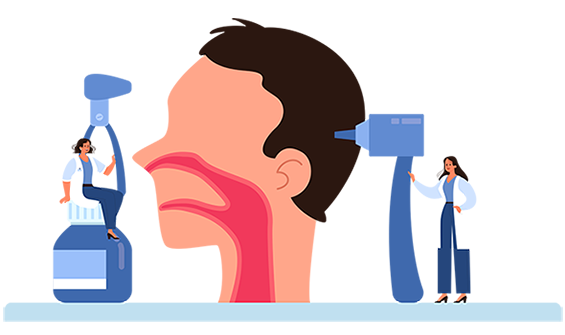Turbinate surgery: Turbinoplasty and turbinectomy
Turbinate reduction for improved nasal breathing
Turbinate surgery is an operation performed to reduce the size of the turbinates. Turbinates are fin-like structures made of a thin plate of bone on the wall of both sides of the nasal passageways. They are covered by soft tissue called mucosa. Turbinates cleanse and humidify the air that passes through the nostrils into the lungs.

As a result of allergies, infection or irritation turbinates can become inflamed or swollen causing nasal blockage, mucous production and congestion. The inferior turbinates are the first tissue to come into contact with outside air and inferior turbinate function includes both respiratory and immune responses. Turbinates may also cause nasal obstruction if they become enlarged as a result of overgrowth of the bone or deviated nasal septum.
Key Points about Turbinoplasty:
Minimally invasive
Surgery is performed from inside the nose with no external cuts or changes in nasal appearance
Can be performed as Day Surgery
Patients can go home the same day in most circumstances
Minimal pain
Patients tend to experience a feeling of congestion post-surgery, without severe pain
Breathe easier
Improved nasal function, improved mucous drainage and better results from nasal medications
Indications for turbinate surgery
The main indication for turbinate surgery is nasal obstruction that has not been controlled by other medical treatments. Initial treatment is often a steroid nasal spray, nasal saline or salt water rinsing and other allergy therapies. These medical treatments are not always effective.
Turbinate surgery may be performed at the same time as a septoplasty to improve the nasal airway, and assist the use of nasal sprays/medications.
How is turbinate surgery done?
Turbinate surgery is performed through the nostrils without any external incisions or cuts. It is performed with small instruments, and telescopes. It is performed under general anaesthetic.
Depending on what other surgery is being performed, it is often a day-case procedure.
The aim of the surgery is to reduce the turbinate size, allowing greater nasal airflow. This is done whilst preserving the lining on the turbinate (the mucosa) so the function is maintained.
Turbinoplasty preparation and aftercare
All patients of Melbourne Sleep Surgery receive detailed information about what to expect before, during and after turbinate reduction as well as risks of the procedure. During consultation Dr Nathan can address any questions or concerns and offer additional information to help patients understand their options and how to take the next step.
Some things to consider are:
- Medications - blood thinners for example can cause bleeding post nasal surgery
- When you are expected back for follow up appointments
- How to care for your nose after surgery
- How physically active you can be after surgery
For the safest and most effective outcome of surgery it is important to follow medical advice.
Turbinoplasty: the procedure
1
Admission to hospital
Detailed instructions will be given prior to admission
2
Operating theatre
General anaesthetic is administered by your anaesthetist
3
Nose preparation
Anaesthetic injections and decongestant into nose for optimal operative conditions
4
After surgery
With nasal/sinus surgery, dissolvable packing is left in the nose to encourage faster healing
5
The next day
Commence rinsing the nose with salty solution, pain relief as needed
6
2-3 weeks post-surgery
Nasal breathing/symptom improvements once swelling subsides
Frequently asked questions about Septoplasty
Any surgical or invasive procedure carries risks. Before proceeding you should seek a second opinion from an appropriately qualified health practitioner.
Associations


